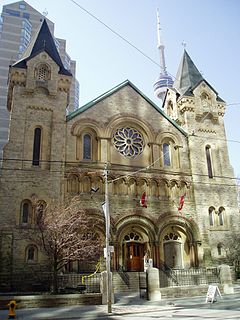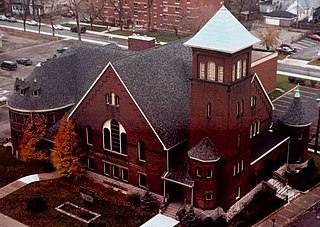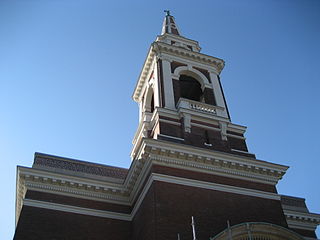
Knox United Church is located in Calgary, Alberta, Canada and is a member church of the United Church of Canada.

Knox United Church is located in Calgary, Alberta, Canada and is a member church of the United Church of Canada.
Knox Presbyterian Church was established in 1883 Rev. James Robertson, Superintendent of the Western Mission for the Presbyterian Church in 1881. Their first church building was opened on October 21, 1883, a small wooden building. It was completed for $1000.
A new, larger, building was constructed at the corner of Centre Street and Seventh Avenue. Designed to seat 330 people it was a stone construction which cost $8,000. As the congregation continued to expand, a subsequent building was erected in 1912-13 at the corner of Fourth Street and Sixth Avenue South, the site of the present day Knox United Church. The church building was designed by Calgary architects Lawson & Fordyce in consultation with Allen & Collens of Boston. The building is one of the most sophisticated examples of Gothic Revival architecture in western Canada. [1]
The church split in 1925 after some members of the congregation voted to join with the United Church of Canada. Those who wished to remain in the Presbyterian Church went on to form a new, separate congregation.
The church has been at front of the movement to welcome gays, lesbians and transgender individuals into the United Church. In March 2007, after a vote at its annual congregational meeting, Knox became an affirming congregation, committed to work for the full inclusion and affirmation of all people in the life and work of the church.
The church has one of the largest Casavant Frères organs in western Canada. This forms the centre of a strong music program. A permanent labyrinth was opened in 2005 and is open for daily meditations. The building is now also well known throughout the area as a venue for musical concerts of all kinds and is working to become more involved in the arts community in Calgary.

Dominion Chalmers United Church is a large United church, located in downtown Ottawa, at the corner of Cooper and O'Connor Streets. It is a 1962 merger of two key congregations from both the Methodist and Presbyterian traditions, each possessing lengthy histories.

The Presbyterian Church in Canada is a Presbyterian denomination, serving in Canada under this name since 1875. The United Church of Canada claimed the right to the name from 1925 to 1939. According to the Canada 2001 Census 409,830 Canadians identify themselves as Presbyterian, that is, 1.4 per cent of the population.

Knox Presbyterian Church is a Presbyterian Church in Ottawa, Ontario, Canada. It is named after John Knox, a founder of Presbyterianism in Scotland.

St. Giles Presbyterian Church is a member of the Presbyterian Church in Canada located in Ottawa, Ontario, Canada. It was formed in 1925 by a minority group from Glebe Presbyterian, and a few other congregations, that did not support the vote to enter the United Church of Canada.

St. Andrew's Church is a historic Presbyterian church located at the corner of King Street West and Simcoe Street in the city's downtown core of Toronto, Ontario, Canada. It was designed by William George Storm in the Romanesque Revival style and completed in 1876.

Knox Presbyterian Church is a Presbyterian church in downtown Toronto, Ontario, Canada.

The Plus 15 or +15 Skyway network in Calgary, Alberta, Canada, is one of the world's most extensive pedestrian skywalk systems, with a total length of 18 kilometres and 62 bridges. The system is so named because the skywalks are approximately 15 feet above street level.

First Presbyterian Church is a historic Presbyterian Church in Canada congregation and Gothic Revival church building in the city's downtown core of Edmonton, Alberta, Canada. The congregation celebrated its 125th anniversary in November 2006.
St. James-Bond United Church, at 1066 Avenue Road in Toronto, Ontario, was a United Church of Canada congregation from 1928 to 2005, when it merged with Fairlawn Heights United Church in the Yonge Street and Lawrence Avenue area. The "St. James-Bond" name derived from the merger of St. James Square Presbyterian Church with Bond Street Congregational Church in 1928. Prior to the merger, they were separate congregations downtown, of the Presbyterian and Congregational traditions respectively.

St. Andrew's Presbyterian Church, is a Presbyterian Church in Canada congregation in downtown Windsor, Ontario, Canada. The congregation dates back to 1857, and at one time, was the largest congregation by membership within the Presbyterian Church in Canada (PCC).

Wellington Church is a congregation and parish church of the Church of Scotland, serving part of the Hillhead area of Glasgow, Scotland. The building is located on University Avenue, Glasgow, opposite the University of Glasgow.

Deer Park United Church is the name of a United Church of Canada congregation, and also the name of this congregation's former church building at 129 St. Clair Avenue West in the Deer Park neighbourhood of Toronto, Ontario, Canada. It was one of two United Church of Canada buildings in the area and along St. Clair Avenue, the other being Timothy Eaton Memorial Church.

The Knox United Church, began as Knox Presbyterian Church in Scarborough, Toronto, Ontario, Canada, in a wood frame church built in 1848, the result of the Church of Scotland disruption, that led to the formation of the Presbyterian Church of Canada in Connection with the Free Church of Scotland.

Many historically significant buildings in Regina, Saskatchewan were lost during the period 1945 through approximately 1970 when the urge to "modernize" overtook developers' and city planners' sense of history and heritage. The old warehouse district to the north of the old CPR tracks was Regina's original commercial raison d'être once Lieutenant-Governor Edgar Dewdney had established the site of his considerable landholdings as the Territorial Capital. With the significant conversion of shipping of commercial goods from train to truck and cancellation of passenger service on the railway, the Warehouse District immediately adjacent to the train line has ceased to be exclusively industrial in character. Some areas of the Warehouse District have been transformed into a shopping, entertainment and residential precinct.

Central Presbyterian Church is a Presbyterian Church in Canada congregation in Hamilton, Ontario, Canada, located in the downtown area at the corner of Charlton and Caroline Street South.

Robertson-Wesley United Church is a church located a short distance west of the downtown core of the city of Edmonton, Alberta, Canada in the neighbourhood of Oliver.

Knox-Metropolitan United Church stands on Lorne Street at Victoria Avenue across from Victoria Park in downtown Regina, Saskatchewan, Canada. It is the current manifestation of Presbyterian and Methodist congregations that date back to "worship services in both traditions…in 1882."

Allen & Collens was an architectural partnership between Francis Richmond Allen and Charles Collens that was active from 1904 to 1931. Allen had previously worked in the Boston-based partnerships Allen & Kenway (1878–91) and Allen & Vance (1896-98), which executed Lathrop House (1901) and Davison House (1902) at Vassar College. The firm was known for its Gothic Revival design work.

The Southam Building was a ten-storey office tower located at 130 7th Avenue Southwest in Calgary, Alberta, Canada. Designed by Montreal architectural firm Brown and Vallance and built between 1912 and 1913, the Southam Building was one of Calgary's best examples of Gothic Revival architecture. Between 1913 and 1932 the building housed the offices of the Calgary Daily Herald, during which time it was also known as the Herald Building. It later served as a Greyhound Bus terminal and was known as the Greyhound Building. The Southam Building was demolished in 1972.
Centre Street Church is an evangelical megachurch located in Calgary, Alberta, Canada, affiliated with the Evangelical Missionary Church of Canada (EMCC). Founded in 1958, it has an average weekly attendance of 7,739 and is considered the largest megachurch in Canada. In addition to its Central Campus, it has four satellite locations in the Calgary Metropolitan Region. Its senior pastor is Dr. Henry Schorr.